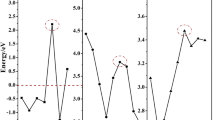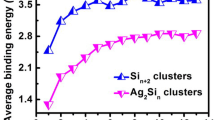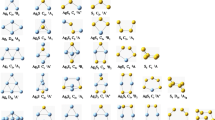Abstract
Silver sulfide is a famous semiconductor, which can be used in many areas. Understanding the size evolution of silver sulfide clusters is useful in controlling their size to improve their properties in applications. The structures of (Ag2S)n (n = 1–8) clusters are explored using a combined method of genetic algorithm (GA) and density functional theory (DFT). The TPSSh/def2-tzvp(Ag)/6-311G(d)(S) method has been used to optimize the structures. The re-optimized structures and refined energies are computed at PBE0/Lanl2tz(Ag)/6-311G(d,p)(S) level according to the benchmark calculations. The global minimum (GM) structures, HOMO and LUMO frontier orbitals, density of states, ionization potentials, electron affinity energies, noncovalent interactions, and natural populations of the clusters have been studied. The clusters evolve from open to cage structures when n varies from 1 to 8. A triangular Ag3S3 unit is found to be an important building block, which can construct the global minimum structures of (Ag2S)n (n = 3–8) clusters. When n > 6, quadrangular Ag4S4 rings present in (Ag2S)n clusters. (Ag2S)6 and (Ag2S)8 clusters are in hollow conformation, and both of which have special stability because of their high HOMO-LUMO gaps, high ionization potentials, and Ag⋯Ag attractive interactions in them.

Graphical abstract






Similar content being viewed by others
References
Kryukov A, Stroyuk A, Zin’chuk N, Korzhak A, Kuchmii SY (2004) Optical and catalytic properties of Ag 2 S nanoparticles. J Mol Catal A Chem 221(1):209–221
Wang P, Yang T, Zhao R, Zhang M (2016) Sulfur antisite-induced intrinsic high-temperature ferromagnetism in Ag2S:Y nanocrystals. Phys Chem Chem Phys 18(15):10123–10128. https://doi.org/10.1039/C5CP07690K
León-Velázquez MS, Irizarry R, Castro-Rosario ME (2010) Nucleation and growth of silver sulfide nanoparticles. J Phys Chem C 114(13):5839–5849. https://doi.org/10.1021/jp911238a
Nakajima A, Kawamata H, Hayase T, Negishi Y, Kaya K (1997) Photoelectron spectroscopy of transition metal-sulfur cluster anions. Z Phys D 40(1):17
Huang W-J, Huang R-B, Liu Z-Y, Zheng L (1998) Laser generation and mass distribution of AgnSm: t and AunSm 土. Acta Chim Sin 56:200–207
Wu Z, Jiang D-e, Lanni E, Bier ME, Jin R (2010) Sequential observation of Ag n S4−(1≤ n≤ 7) gas phase clusters in MS/MS and prediction of their structures. J Phys Chem Lett 1(9):1423–1427
Liu H, Hu W, Ye F, Ding Y, Yang J (2013) Growth mechanism of Ag2S nanocrystals in a nonpolar organic solvent. RSC Adv 3(2):616–622. https://doi.org/10.1039/C2RA21712K
Chen J, Kong Y, Ji J, Ruan J, Wang K, Gao F, Cui D (2012) Protein-induced structural evolution of silver sulfide at the nanoscale: from hollow particles to solid spheres. Nanoscale 4(15):4455–4458. https://doi.org/10.1039/C2NR30621B
Dixon DA, Gole JL (1992) Description of the ground state electronic structures of Cu2O, Cu2S, Ag2O and Ag2S. Chem Phys Lett 189(4):390–394. https://doi.org/10.1016/0009-2614(92)85220-5
Li Y-F, Li Y, Li Y, Tan J-J, Li H-L (2016) Structural and electronic properties of small silver–sulfur clusters: a density functional study. Physica B 499:29–37. https://doi.org/10.1016/j.physb.2016.07.003
Bagatur’yants AA, Safonov AA, Stoll H, Werner H-J (1998) Ab initio relativistic pseudopotential study of small silver and gold sulfide clusters (M2S) n, n= 1 and 2. J Chem Phys 109(8):3096–3107
He X, Wang Y, Gao C-Y, Jiang H, Zhao L (2015) A macrocycle-assisted nanoparticlization process for bulk Ag 2 S. Chem Sci 6(1):654–658
Tian Z, Cheng L (2015) Perspectives on the energy landscape of Au–Cl binary systems from the structural phase diagram of AuxCly (x + y = 20). Phys Chem Chem Phys 17(20):13421–13428. https://doi.org/10.1039/C5CP01863C
Liu Y, Tian Z, Cheng L (2016) Size evolution and ligand effects on the structures and stability of (AuL)n (L = Cl, SH, SCH3, PH2, P(CH3)2, n = 1–13) clusters. RSC Adv 6(6):4705–4712. https://doi.org/10.1039/C5RA22741K
Feng Y, Cheng L (2015) Structural evolution of (Au2S)n (n = 1–8) clusters from first principles global optimization. RSC Adv 5(77):62543–62550. https://doi.org/10.1039/C5RA06137G
Tian Z, Cheng L (2016) First principles study on the structural evolution and properties of (MCl)n (n = 1–12, M = Cu, Ag) clusters. RSC Adv 6(36):30311–30319. https://doi.org/10.1039/C6RA01258B
Hay PJ, Wadt WR (1985) Ab initio effective core potentials for molecular calculations. Potentials for K to Au including the outermost core orbitals. J Chem Phys 82(1):299–310. https://doi.org/10.1063/1.448975
Tao J, Perdew JP, Staroverov VN, Scuseria GE (2003) Climbing the density functional ladder: nonempirical meta–generalized gradient approximation designed for molecules and solids. Phys Rev Lett 91(14):146401
Petersson GA, Bennett A, Tensfeldt TG, Al-Laham MA, Shirley WA, Mantzaris J (1988) A complete basis set model chemistry. I. the total energies of closed-shell atoms and hydrides of the first-row elements. J Chem Phys 89(4):2193–2218. https://doi.org/10.1063/1.455064
McLean AD, Chandler GS (1980) Contracted Gaussian basis sets for molecular calculations. I. Second row atoms, Z=11–18. J Chem Phys 72(10):5639–5648. https://doi.org/10.1063/1.438980
Andrae D, Häußermann U, Dolg M, Stoll H, Preuß H (1990) Energy-adjusted ab initio pseudopotentials for the second and third row transition elements. Theor Chim Acta 77(2):123–141. https://doi.org/10.1007/BF01114537
Frisch MTG, Schlegel HB, Scuseria G, Robb M, Cheeseman J, Scalmani G, Barone V, Mennucci B, Petersson G et al (2009) Gaussian 09, Revision A 02. Gaussian Inc, Wallingford
Pople JA, Head-Gordon M, Raghavachari K (1987) Quadratic configuration interaction. A general technique for determining electron correlation energies. J Chem Phys 87(10):5968–5975. https://doi.org/10.1063/1.453520
Barone V, Chong DP (eds) (1996) Recent advances in density functional methods, part I. recent advances in computational chemistry, vol 1. World Scientific Publ. Co, Singapore. https://doi.org/10.1142/4865
Becke AD (1988) Density-functional exchange-energy approximation with correct asymptotic behavior. Phys Rev A 38(6):3098–3100. https://doi.org/10.1103/PhysRevA.38.3098
Zhao Y, Truhlar DG (2008) The M06 suite of density functionals for main group thermochemistry, thermochemical kinetics, noncovalent interactions, excited states, and transition elements: two new functionals and systematic testing of four M06-class functionals and 12 other functionals. Theor Chem Accounts 120(1):215–241. https://doi.org/10.1007/s00214-007-0310-x
McDouall JJW, Peasley K, Robb MA (1988) A simple MC SCF perturbation theory: orthogonal valence bond Møller-Plesset 2 (OVB MP2). Chem Phys Lett 148(2):183–189. https://doi.org/10.1016/0009-2614(88)80296-3
Perdew JP, Burke K, Ernzerhof M (1996) Generalized gradient approximation made simple. Phys Rev Lett 77(18):3865–3868. https://doi.org/10.1103/PhysRevLett.77.3865
Deng W, Cheeseman JR, Frisch MJ (2006) Calculation of nuclear spin−spin coupling constants of molecules with first and second row atoms in study of basis set dependence. J Chem Theor Comput 2(4):1028–1037. https://doi.org/10.1021/ct600110u
Weigend F, Ahlrichs R (2005) Balanced basis sets of split valence, triple zeta valence and quadruple zeta valence quality for H to Rn: design and assessment of accuracy. Phys Chem Chem Phys 7(18):3297–3305. https://doi.org/10.1039/B508541A
Han L-L, Kuang X-Y, Ding L-P, Shao P, Jin Y-Y, Li H-H (2014) Probing the geometries, relative stabilities, and electronic properties of neutral and anionic AgnSm (n+ m≤ 7) clusters. J Mol Model 20(5):1–10
Dehnen S, Schäfer A, Ahlrichs R, Fenske D (1996) An ab initio study of structures and energetics of copper sulfide clusters. Chem Eur J 2(4):429–435. https://doi.org/10.1002/chem.19960020412
Joo Kim S, Seong Dae K, Yeol Park J, Yong Lee J, Min Yuk J (2017) Hollow Ag2S nanosphere formation via electron beam-assisted oxidative etching of Ag nanoparticles. Chem Commun 53(81):11122–11125. https://doi.org/10.1039/C7CC06223K
Lu T, Chen F (2012) Multiwfn: a multifunctional wavefunction analyzer. J Comput Chem 33(5):580–592. https://doi.org/10.1002/jcc.22885
Bondi A (1964) van der Waals Volumes and Radii. J Phys Chem 68(3):441
Tian Z, Song C, Wang C, Liu Z, Liao R (2019) Theoretical characterization of (CuF)n (n = 1–12) clusters. Comput Theor Chem 1157:28–33. https://doi.org/10.1016/j.comptc.2019.04.001
Cheng H, Cheng L (2015) Secondary bonding networks in small (HgS) n clusters: a theoretical investigation. Comput Theor Chem 1060:36–42
Humphrey W, Dalke A, Schulten K (1996) VMD: visual molecular dynamics. J Mol Graph 14(1):33–38. https://doi.org/10.1016/0263-7855(96)00018-5
Johnson ER, Keinan S, Mori-Sánchez P, Contreras-García J, Cohen AJ, Yang WT (2010) Revealing noncovalent interactions. J Am Chem Soc 132(18):6498
Acknowledgments
The calculations were carried out on the Theoretical and Computational Chemistry LAB, School of Chemistry and Materials Engineering, Fuyang Normal University, China.
Funding
This work received financial support from the Fuyang Normal University (2017FSKJ01ZD), 2017 Fuyang municipal government-Fuyang Normal University horizontal cooperation project (XDHX201719).
Author information
Authors and Affiliations
Corresponding author
Ethics declarations
Conflict of interest
The authors declare that they have no conflict of interest.
Additional information
Publisher’s note
Springer Nature remains neutral with regard to jurisdictional claims in published maps and institutional affiliations.
Electronic supplementary material
ESM 1
(DOCX 619 kb)
Rights and permissions
About this article
Cite this article
Song, C., Tian, Z. Systematic study on the structures and properties of (Ag2S)n (n = 1–8) clusters. J Mol Model 25, 310 (2019). https://doi.org/10.1007/s00894-019-4191-4
Received:
Accepted:
Published:
DOI: https://doi.org/10.1007/s00894-019-4191-4




